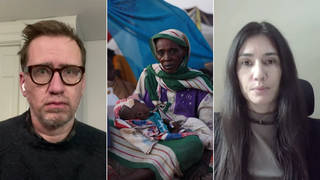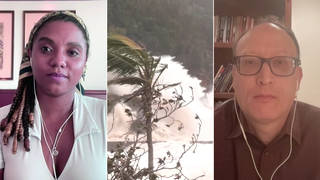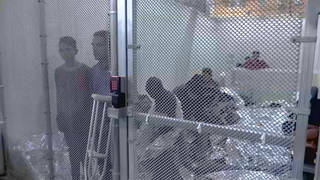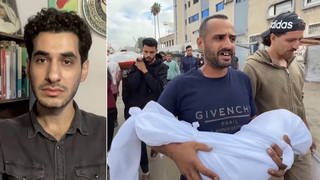
Guests
- Franco OrdoñezWhite House correspondent for the McClatchy Washington Bureau. His latest exclusive is headlined “Trump Looking to Erect Tent Cities to House Unaccompanied Children.”
- Renée FeltzDemocracy Now! correspondent and producer who has long reported on the criminalization of immigrants, family detention and the business of detention.
The Trump administration is reportedly planning to build tent cities on military bases near the U.S.-Mexico border to accommodate the increasing numbers of migrant children being held in detention centers. According to McClatchy, Department of Health and Human Services officials are due to visit Fort Bliss, an Army base near El Paso, Texas, in the coming weeks to look at the land where they’re considering building a tent city. HHS detention shelters are 95 percent full and hold more than 10,000 children. The number of migrant children in custody has recently surged by over 20 percent, and a tent city could temporarily accommodate an additional 1,000 to 5,000. In Washington, D.C., we speak with the reporter who broke the story, Franco Ordoñez. He is the White House correspondent for the McClatchy Washington Bureau.
Transcript
NERMEEN SHAIKH: The Trump administration is reportedly planning to build tent cities on military bases near the U.S.-Mexico border to accommodate the increasing numbers of migrant children being held in detention centers. According to McClatchy, Department of Health and Human Services officials are due to visit Fort Bliss, an Army base near El Paso, Texas, in the coming weeks to look at the land where they’re considering building a tent city. HHS detention shelters are 95 percent full and hold more than 10,000 children. The number of migrant children in custody has recently surged by over 20 percent, and a tent city could temporarily accommodate an additional 1,000 to 5,000 children.
AMY GOODMAN: To talk more about this exclusive, we go to Washington, D.C., to speak with the reporter who broke the story, Franco Ordoñez, White House correspondent for McClatchy Washington Bureau. His latest exclusive is headlined “Trump looking to erect tent cities to house unaccompanied children.”
Franco, welcome back to Democracy Now! We’re also still joined by Democracy Now!’s Renée Feltz. Talk about what you found. Tent cities on military bases?
FRANCO ORDOÑEZ: Yes. I mean, essentially, the Trump administration is going to go down to Fort Bliss, as early as this week, to start looking at a parcel of land, there on that very wide and vast base in South Texas, near El Paso, to see if they can build a series of tents to house, as you pointed out, as many as 1,000 to 5,000 children. It would be a massive project, potentially raise the capacity of the people at the base to another 20,000 people to service these individuals. The administration currently says that this is a, you know, a site visit. They’re going to check it out. They’re not guaranteeing that they will build it. But according to my sources, this is pretty far along, if they’re talking about the number of beds and the number of new staff that they will need to bring in to take care of this.
NERMEEN SHAIKH: And, Franco, could you explain what is the logic of building these tent cities or attempting to build these, planning to build these tent cities on military bases?
FRANCO ORDOÑEZ: Well, essentially, they’re running out of space, as you and Renée had pointed out about the “zero tolerance” policy, that there are so many children who are now being separated from their parents—20 percent increase in just the last month, from April to May—that these facilities where children are held has reached near capacity, so they need more space to bring—to put children.
Now, the tent cities are just for unaccompanied children, but there’s no more room to put them in the other child shelters. So they need these places to put the children. HHS says this is prudent work, that they will be safe, that they will be in protective environment, but they need temporary facilities that they can put up and put down depending on the rate of migration trends. As you know, migration trends change over the year: They rise in the spring and the summer; they go down, traditionally, in the fall and winter, in colder months. So they want some flexibility and places to have these children.
AMY GOODMAN: Franco Ordoñez, describe Fort Bliss, the military base near El Paso, Texas, where they’re going to erect one of these tent cities. And talk about the—who is behind this. Franco, did you hear my question? We’re talking to Franco Ordoñez, a White House correspondent for the McClatchy Washington Bureau. Renée, your thoughts on just coming from the South Texas border?
RENÉE FELTZ: Well, it’s interesting Fort Bliss is in El Paso. That’s a total extreme other opposite end of Texas. And it just goes to show how many places they’re detaining so many children, that they need to build a new tent city all the way in El Paso. We just got done talking about the Rio Grande Valley.
The other thing I would say, to build on what Franco was saying there, is that these facilities where they hold the unaccompanied children—a manufactured crisis, children separated from their parents—are full, but they’re full because the children are being held longer, instead of being released. And they’re being held longer while their sponsors are vetted, and they’re being held longer, in part, because, as we pointed out earlier, they have to represent themselves in immigration court.
AMY GOODMAN: So, let’s go back to that issue of Fort Bliss, where one of the tent cities would be erected, Franco Ordoñez, if you could describe it. And also, who is behind these orders? And what’s the House involvement, as well?
FRANCO ORDOÑEZ: So, essentially, you know, these tent cities, they are still being considered. But you can imagine, because let’s remember also that these—this is not—this is not setting some new precedent. This has happened under President Obama. They did erect some tent cities on military bases. One tent city that was erected was in Homestead, in Florida. What you could imagine—and what was there was these massive white tents. Children were brought in. They had food, clothes. They had recreational facilities. I was told—I did not see this firsthand, but I was told—there were some Zumba-like classes for children and other play—being able to play soccer. Those are the kind of facilities that would likely be in Fort Bliss.
Who’s behind it? Department of Health and Homeland [sic] Services is the one who’s responsible for taking care of these kids. Right now, there’s about 11,200 kids without parents who are now held in custody. So it’ll be Health and Human Services and the Office of Refugee Resettlement who will be taking care of these kids at these facilities.
NERMEEN SHAIKH: And, Franco, can you explain? You said that, of course, people have been detained under the Obama administration, as well, and previous administrations. What has the Trump administration done on this issue that previous administrations have not?
FRANCO ORDOÑEZ: Well, what the—the Obama administration, interestingly enough, did a lot of the same things that the Trump administration did: detain families, as Renée’s report pointed out, sanctuary—you know, target some—put children on military bases, put National Guard on the border. What the Obama administration, though, however, stopped short of, which is so critical now, is separating families. Jeh Johnson, this week, the former Department of Homeland Security secretary, said, in interviews, that he would not—he just could not separate the families. It was a step too far.
AMY GOODMAN: Actually, Franco Ordoñez, we have Jeh Johnson saying just that.
JEH JOHNSON: For three years, I had the responsibility for enforcing our immigration laws. And in three years, on my watch, we probably deported or returned or repatriated about a million people to enforce border security. One of the things that I could not do is separate a child from his or her mother and literally pull a child from its mother’s arms.
AMY GOODMAN: Jeh Johnson was Obama’s homeland security secretary. Continue, Franco Ordoñez.
FRANCO ORDOÑEZ: Well, I just want to point out that, you know, Jeh Johnson said that, as he just said there, that they wouldn’t separate the families. I will say that they did raise that possibility under his administration at the family detention centers, when they were fighting to keep the parents and children together. But it is a step that the Obama administration has not taken that the Trump administration has. Like Renée, I covered a lot of the family detention issues. I’ve spoken, just this week, with some of the lawyers who represented those families. And while they were very concerned about Obama, they’re a lot more concerned about Trump and feel like he is going two more steps than Obama did.
AMY GOODMAN: And finally—finally, Franco, your latest piece, “Lobbyists given draft documents outlining House leaders’ contentious immigration proposal.” We have 20 seconds. Who are the lobbyists? Why do they know what the American people don’t know?
FRANCO ORDOÑEZ: I believe that question was to me—you’re kind of bouncing in and out. But the lobbyists, a lot of the lobbyists are the detention centers. They’re detention centers, groups like GEO, groups like CCA, groups that will kind of be behind these tent cities, that will be hired to man them, the health service organizations that will be there. And they will be there who will be able to profit from these organizations—from these facilities.
AMY GOODMAN: Franco Ordoñez, we want to thank you for being with us, White House correspondent for McClatchy Washington Bureau. And, Renée Feltz, thanks so much.












Media Options